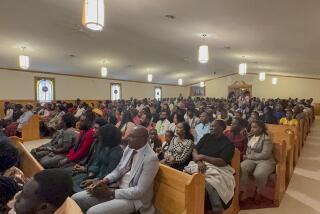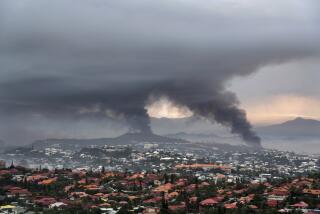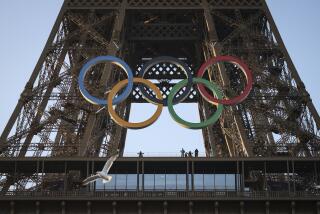‘The Other France’ Is Peopled With Anger, Poverty and Despair
CHANTELOUP-LES-VIGNES, France — In the bleak housing projects ringing Paris, so tense that police fear to patrol them, young Arabs, Africans and poor whites are fast slipping into a desperate underclass.
A 17-year-old Portuguese named Tonio is one of them.
“Look, I steal, I deal drugs,” he said, with a casual shrug. “There’s no choice around here but to take the train to Paris and beat up a few Frenchmen for money to live.”
Tonio loitered in a concrete ghetto near this lovely old village set in lush countryside just beyond the glow of Paris. His pal, Mamadou Sissoko, a Mauritanian rapper in a Yankees cap, spat toward the mean streets named for poets and painters he could not place.
“Here there is nothing,” Mamadou added. “Nothing. Nothing. You understand nothing? I mean nothing.”
In all, 4 million people live in what the government calls “sensitive neighborhoods” near French cities--perhaps a quarter of them just outside Paris. Half are under 25, and many are children of immigrants who were welcome workers during the boom years but are jobless outcasts in the hard-pressed ‘90s.
Most Parisians know little of this other France, beyond the occasional murder or riot that makes the newspapers. Few dare to venture even close.
But the nearest ghetto is within sight of Sacre Coeur Cathedral atop Montmartre. Others nestle in the lazy loops of the Seine, where painters once captured peaceful scenes in dappled light.
In some, there is tenuous calm and a promising community spirit. In others, order is imposed by drug mafias and local toughs. Mostly, as Tonio puts it, “It is the law of the jungle.”
Deaths in the “sensitive neighborhoods” are more often by overdose or suicide than gunshots, and there are no drive-by shootings. But authorities fear the worst is yet to come.
“We are headed for a downward spiral, American-style,” said Patrice Bonhomme, police chief for the Chanteloup area, northwest of Paris.
In May, thousands of police in street clothes marched in protest through the heart of Paris. They said they were too few and too lightly armed to patrol la banlieue. The word means suburbs, but refers to the ring of hot spots.
At one outpost, protesters said, 15 officers share four bulletproof vests. Banlieue hostility was cited as a main reason for the growing number of police suicides: 83 in 18 months.
Chanteloup’s Noe ghetto of 8,000 people at the edge of a lovely old winemaking village is not the worst. But, residents say, it is bad enough.
Noe was the backdrop for “La Haine” (Hatred), a film depicting a day in the suburbs. It ends in gunplay, the mutual murder of good and evil, and no one is sure which is which.
The ghetto sprang up overnight in the 1970s, meant as a well-planned project for workers at a nearby auto plant. A real-estate scandal left it half-done, with no amenities. Then the plant closed.
Today, few youths even think about finding work. Unemployment runs to 25%, normal for the banlieue, but twice the national level.
This year, its crime rate rose 45% in four months. Many offenders are 10 to 13 years old. One teenager was arrested and released 17 times for everything from vandalism to armed robbery.
Families lock themselves in at night. In late May, 50 youths stormed the police station to free two friends arrested earlier for beating a passerby to a bloody mess within sight of the police.
Although firearms are tightly controlled in France, youths secret away handguns picked up during burglaries.
But Chanteloup is a bucolic paradise next to “Les 4,000” in Courneuve, just north of Paris, a vast high-rise slum of grim corridors.
Dealers sell heroin out front without bothering to hide. Lookouts warn when strangers approach. Plainclothes police are obvious to the initiated. Patrol cars sometimes escape in reverse under a hail of rocks. Arrests are made in predawn lightning raids.
Residents ignore the thieves and dealers. Few report crime or testify, fearing reprisal when overworked judges turn prisoners loose.
The Quartier de la Luth neighborhood of Gennevilliers is another thriving drug market. When police come, dealers melt away. Officers make occasional raids, with help from the national riot police. But they are sometimes injured by flying stones.
Only half in jest, Police Chief Alain Winter evoked Palestinian stone-throwing in the West Bank. “It’s a regular Intifada here,” he said.
National leaders insist they are coming to grips with the problem.
“This is much less serious than Chicago or Birmingham,” Eric Raoult, urban affairs minister, said in an interview. “France will not accept that certain individuals are left behind.”
But Chanteloup Mayor Pierre Cardo, a champion of better conditions in the suburbs, is pessimistic. He says authorities are only now taking action that should have been done 20 years ago.
Along with renovating buildings, he says, the state must hire young people to work within their communities to restore order, encourage new enterprises and offer some prospects for the future.
“If we don’t create jobs, give people some dignity and hope,” he said, “we’ll see mounting violence, a takeover by mafias, unpredictable explosions and a revolt by the middle class.”
Already, he noted, the far-right National Front excoriates non-white immigrants, blaming them for unemployment, crime and a loss of the French character. Its supporters number more than 30% in some communities.
Cardo’s message is echoed all around the banlieue, where scattered enclaves are interspersed with lavish stone chateaux, leafy forests and comfortable homes.
Most of these pockets date back to the 1960s, when a wave of immigrant workers coincided with a grand plan to build new high-density housing projects for low-income families.
In recent years, Algerians, Moroccans, Africans and other destitute families were steered toward the deteriorating projects, and many of the original French residents moved out.
As the families grew--many have more than six children--they spilled out of their cramped spaces.
Now France stops where the mean streets begin.
At Chanteloup, dead white men gaze down from mosaics on the walls: Blaise Pascal with his perpetual headache; Einstein, looking wise; Rimbaud, smug.
Today’s local heroes are Michael Jordan and rappers such as Busta Rhyme or Notorious Big. The slang is French-based, but the dirtiest words are American. Everyone knows about the Bloods and the Crips.
In most banlieue projects, the south walls of buildings bristle with satellite dishes turned toward North Africa and the Middle East. Some residents can’t speak French, and many don’t want to.
On Islamic holidays, most of Montfermeil rises early for outside prayers. On Eid-al-Adha, Muslims sacrifice lambs to howls of protest from French neighbors.
Alongside the sea of barefoot worshippers, a mound of shoes tells the story: gleaming white Nike Airs are jumbled against pointy yellow Senegalese slippers and worn-out rubber shower thongs.
Some young North Africans find refuge among the sort of Islamic extremists who planted bombs around France last year. Far more reject their parents’ beliefs in all forms, finding themselves in a rootless cultural limbo that is neither Arabic nor French.
The mood everywhere is tense. When a reporter phoned the Little Sisters of Jesus who work in Courneuve, Sister Genevieve said, “We need a bit of time for reflection. Call back in a year or two.”
On a Saturday at the synagogue in Courneuve, unmarked, without even the obligatory tiny parchment scroll on the doorframe, a young man in a yarmulke said, “Go away,” and slammed the armored door.
Only a few businesses survive the repeated holdups and vandalism. A single cafe serves all of Noe in Chanteloup.
Recreational facilities are few. The city of Montfermeil built a music hall in Les Bosquets, but after it stayed empty for two years because of a lack of funds, frustrated kids demolished it.
The only basketball hoops in Noe were removed after Mamadou Sissoko’s friend Musa cut off a finger making a dunk shot on a broken rim.
Government workers and local volunteers try to make life better with job counseling, sports programs, theater groups, financial planning and specialized training.
The French welfare system assures medical care and minimum monthly family income that ranges from $500 to well over $1,000. Few people are evicted even if they cannot pay rent.
There are dropouts, but most kids go to school. So far, violence usually stops at bloodied heads.
But residents of the neighborhoods say the problem is not meeting the bare necessities of life but rather living like those they see around them.
The government’s idea is for individuals to melt into the pot, the way immigrants have always done in France, rather than stay in their own tight communities. This does not seem to be happening.
People with low incomes, whose skin color and facial features mark them as non-white, say they are routinely turned away by employers and bankers, even if they have French citizenship.
In Courneuve, Siby Sidaty, a deliveryman who heads the Assn. of Malian Workers in France, is still struggling after 28 years at the edge of Paris. He sees dangerous frustration.
“We try hard to fit in,” he said. “But you can only take so much. We are obliged to like normal French people. Our kids want the same ice cream and clothes they see around them.”
Social workers see a new problem among a generation of youths, born in France with French nationality, who have never seen their parents go to work.
Other youngsters watch fathers work hard all their lives only to drag home to the same grim banlieue with a paycheck that hardly gets the family through the month.
“For them, the horizon stops at the concrete patch outside their doors,” said Claude Ney, Cardo’s aide. “What do you expect them to do? If you don’t help them advance, you’ll pay the price.”
Parental authority is breaking down, he said. At 3 a.m., gangs of kids only 7 or 8 years old roam the streets. He was worried about the firearms that youths acquire on burglary sprees.
Raoult, the minister, is hopeful that an ambitious new Banlieue Plan will attract businesses to the worst areas, where taxes have been lowered, and state investment will improve housing conditions.
It would spend $1 billion to refurbish a half-million apartments and add both teachers and police to troubled areas.
But the plan is still a bill that faces a tough legislature. The far-right says it squanders money better spent on people of French roots. Many academics call it a drop in the bucket, less than what is spent to bail out Air France.
Many residents dismiss the plan, insisting that nothing will change until there are more jobs and a reliable transport system so workers can get to them.
They say better housing depends heavily on private owners who collect rent but do no maintenance.
There are bright spots.
In Gennevilliers, a teacher named Yves--he would not give his last name--turned a hose on his laughing and frolicking kindergarten class, in bathing suits for recess.
“These kids are bright and curious,” he said. “Maybe when they’re old enough to work, they’ll face a different sort of world.”
But in Chanteloup, Hamida Mzedada from the Comores kept an eagle eye on her 2-year-old daughter, playing on the concrete by a wall scrawled with obscene graffiti.
“She won’t know this place when she grows up,” Mzedada said. “I don’t how I’ll do it, but I’m getting us out of here.’
More to Read
Sign up for Essential California
The most important California stories and recommendations in your inbox every morning.
You may occasionally receive promotional content from the Los Angeles Times.










